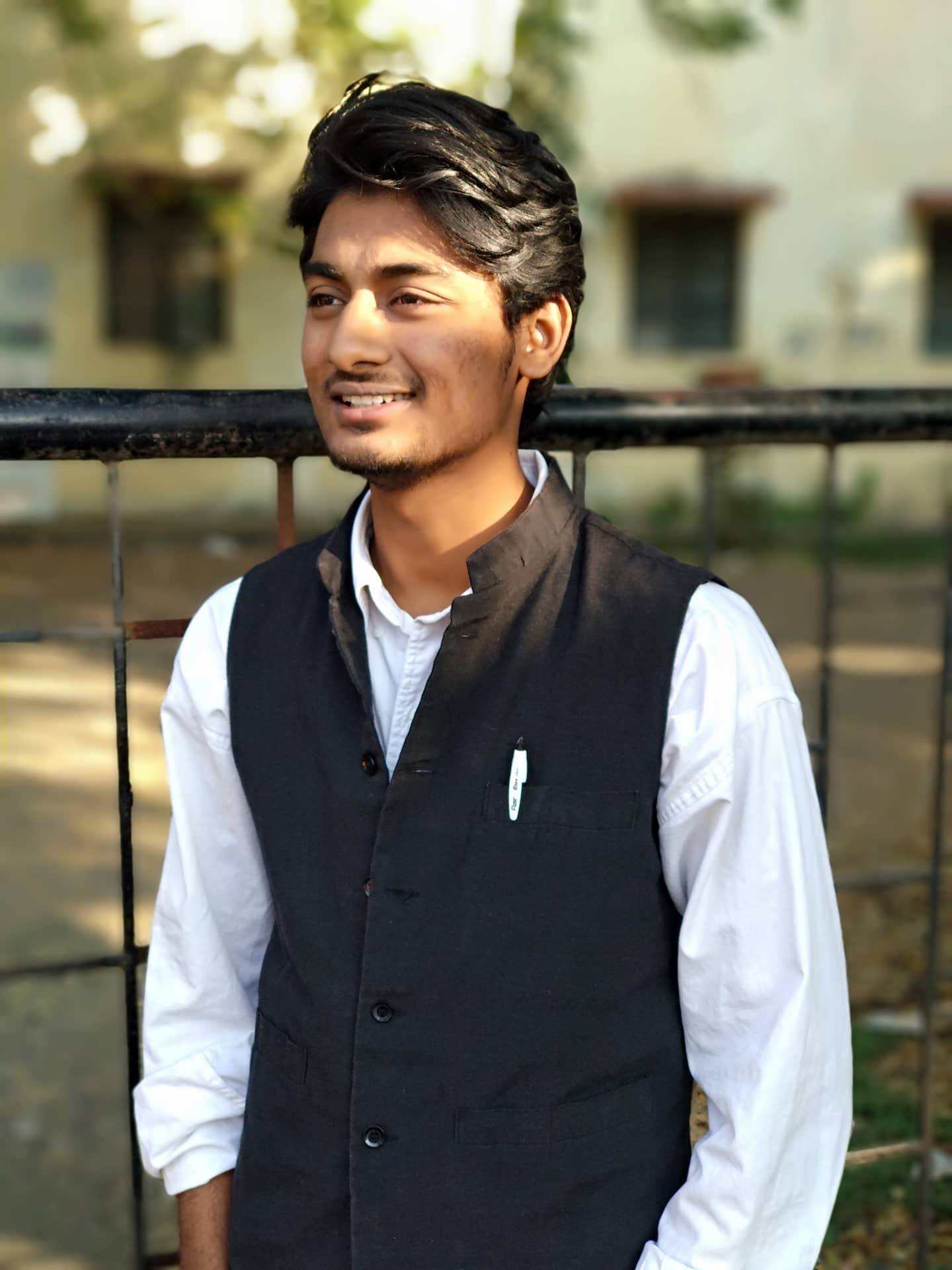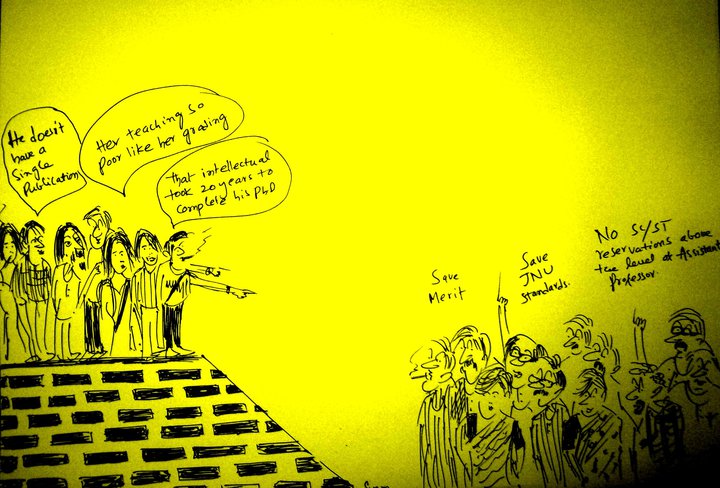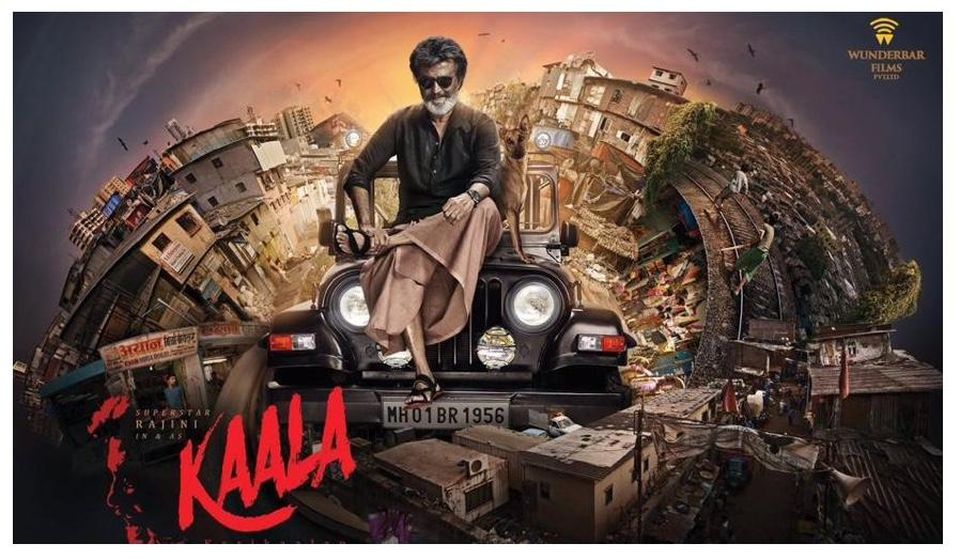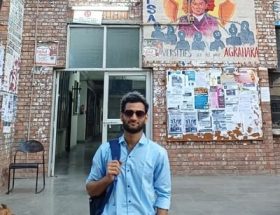Utkarsh Manav
 If one has to theorize a concept where people at a specific space and time come together to form a system where 1) they are governed by themselves, 2) they follow a set of rules and regulation, 3) they all are equal in status and 4) where they all are part of a totality where freedom and moral responsibilities comes together, then such a person will have to take refuge to a word like Democracy. Etymology of ‘Democracy’ indicates that this word is from two Greek words: ‘Demos’ meaning people and ‘Kratia’ meaning power or rule and the word democracy literally means ‘rule by the people’. This word fails to include all the criteria mentioned above; especially the third and fourth. The western term called democracy somehow ends up explaining a ‘form of a government’ or ‘rule’. This explains more of Kratia, that is power, but fails to explain the Demos that is ‘the people’.
If one has to theorize a concept where people at a specific space and time come together to form a system where 1) they are governed by themselves, 2) they follow a set of rules and regulation, 3) they all are equal in status and 4) where they all are part of a totality where freedom and moral responsibilities comes together, then such a person will have to take refuge to a word like Democracy. Etymology of ‘Democracy’ indicates that this word is from two Greek words: ‘Demos’ meaning people and ‘Kratia’ meaning power or rule and the word democracy literally means ‘rule by the people’. This word fails to include all the criteria mentioned above; especially the third and fourth. The western term called democracy somehow ends up explaining a ‘form of a government’ or ‘rule’. This explains more of Kratia, that is power, but fails to explain the Demos that is ‘the people’.
The term Sangha more rightly does justice to all the criteria mentioned above. In fact, the term ‘Sangha’ emphasizes more on the third and fourth criteria. This term has more to do with ‘people’ than the ‘power’. Buddha asked his followers amongst who were Brahmins, to shed their identities and become a part of an entity called Sangha just like an ocean assimilating different incoming waters (Ambedkar, 2002). So as to say Sangha was more focused on social democracy as it tried to break the vertical hierarchy of caste, class and gender. This might be the reason why Babasaheb expressed his concern over democracy in India and preferred ‘social democracy’ over ‘political democracy’ for he knew that political power will be exercised by those who have social power (Ambedkar, 1994). And the one thing for which India is known today across the world is its caste system. Where there is a Caste system there can be no Nation in practice. Their subjective location of being at a higher position in a caste society could be the reason why Indian scholars or theorists hardly mention Buddha’s Sangha while talking about the historical evolution of Democracy and have to refer to the western ideas to find roots of democracy.
Psychology of Castes
While theorizing and historicizing caste Dr. Ambedkar used anthropological, etymological, sociological and economical conceptual tools. He not only criticized the epistemological world of the existing dominant colonialist’s and Indologist’s positivist dictum but also at the same time searched for new methods. This task was next to impossible because he was to theorize from ‘obscure realities of the past’ (Bagade, 2015). Dr. Ambedkar himself argued at many instances that history of India is broken into pieces. His work is an art wherein he restructured and reconstructed the history from an abstract (Bagade, 2015). He used circumstantial evidence of presumptive character that led him to firmly reject the popular conceptions such as that ‘caste was based on racial or occupational differences’ (Bagade, 2015). His findings that ‘controlling the sexuality of women preserve and propagate caste’ is the most effective explanation. His findings not only exposed the trickery of caste and patriarchy but also rejected the Marxist interpretation of Indian history.
Dr. Ambedkar in his thesis ‘Castes in India: Their Mechanism Genesis and Development’ pointed out that it was the Brahmin caste which first closed its door through ‘superimposition of endogamy over exogamy’ and other castes emulated this through what he calls ‘infection of imitation’ (Ambedkar, 2011). Though Christophe Jeffrelot argues that it was the colonial administrators like E. T. Atkinson and Alfred Lyall who described the process (Jeffrelot, 2005), it was Dr. Ambedkar who went deeper to explore the causal reasons behind this ‘process’. Dr. Ambedkar was the first to utilize psychology as his epistemological tool when he conceptualized this process and identified ‘caste as a state of mind’.
Now the question that needs to be answered is ‘how this small population was able to control the large population?’ As stated earlier that Dr. Ambedkar rightly pointed out that caste is a state of mind and hence to control this population is to control their minds. Dr. Ambedkar argues that ‘circumstances making man unenthusiastic have been maintained for thousands of years, then at the most such people will be produced who would fill their stomach by clerical jobs….The reason behind man’s enthusiasm is mind’ (Ambedkar, 2015). Varna system that synthesized into Castes or Jati was embedded in the religion. Taking refuge in different egalitarian or emancipatory religions like Islam, Christianity or Sikhism the upper castes carried their caste with them; this led to the synthesis of these religions into caste groups. How was caste able to maintain its hold in this transition? The question here is again answered by Dr. Ambedkar
Dr. Ambedkar points out that the ‘approbation’ and ‘disapprobation’ for certain behaviors leads to the formation of a ‘habit’ (Bagade, 2015). American Journal for Psychology defines habit as a ‘fixed way of thinking or feeling acquired through previous repetition of a mental experience’. Dr Ambedkar argues that ‘a certain way becomes a folkway and acts in conformity with an established folkway, receives approbation and acts contrary to it is regarded as disapprobation’ (Bagade, 2015). This is how a habit formation takes shape. Charles Duhigg introduces a term called ‘Habit loop’ in his book ‘The Power of Habit’. He argues that for a ‘habit formation’ three steps are intertwined neurologically. These three steps are: 1) cue: meaning a trigger for behavior to automatically start; 2) Routine: the behavior itself and 3) reward: what we get out of that activity (Duhigg, 2012). In the Indian context, we can see this ‘habit loop’ forming through approbation and disapprobation. To marry in the same caste gives rewards such as a right to inheritance whereas to marry outside the caste brings disapprobation in the form of excommunication and loss of the right to inheritance. This is the reason why even today more than 95% marriages in India are caste-marriages1 and it has become a habit that works unconsciously.
This phenomenon is not related only to marriage, it is there in birth ceremony, the name of the child, the surnames, the food we eat, the language we speak, the sound we hear, the sight we see, the occupation we wish to do, the education we take, the birthday ceremony, death ceremony, marriage ceremony, whom we are attracted to, whom we hate, whom we should (pseudo) love etc. Each and every aspect of our life is controlled by caste mentality. Research conducted by Phillippa Lally found out that for a habit to form (in a given context) it requires 18 to 254 days and here we are talking about a habit that formed and took shape for more than 2000 years. This was possible because all these daily life activities were controlled, sanctioned and consecrated by religion. These habits have become so strong that even a change in religion could not de-caste their mentality because these religions ignored the context in which castes was produced.
Brahmincracy
From the above arguments, it can be established that the minds of the majority in this country are controlled by the ‘caste mentality’. In the caste hierarchy Brahmin stands at the summit and hence these minds of the majority are in direct control of this small minority. Hence to define Indian society using western terminologies (as has been habitually done by scholars and theorists) is problematic because these terms emerged from western context and tend to veil the Indian caste structured society. Brahmincracy is a form of control (political, social, economic and psychological) that is established by Brahmins over a majority of population through a process of psychological manipulation. This psychological manipulation happens at the level of social unconsciousness. On this basis to call this country as a ‘Nation that is established on constitutional democracy’ is wrong; it can aptly be called a piece of land where caste groups are made to reside in complete (pseudo) harmony where the political power resides in the hands of few.
Psychologist Carl Jung through his extensive works argues that subliminal aspects of everything that happens to us may seem to play a very little part in our daily lives, but they are the almost invisible roots of our conscious thoughts. Further Jung states that ‘our past experiences and future aspirations are the causes of our behavior’. In the Indian context, ‘caste’ has become not only the ‘past experience’ but also the ‘future aspiration’ (McLeod, 2018). The image of self in this structure is itself constructed by upper castes and when any Dalit or Adivasi or Bahujan tries to redefine that image she is brutally suppressed and resisted.
In this context to imply the term Democracy could be a foul because it fails to account for the ‘graded inequality’ that is ingrained in its people (Ambedkar, 2011). The right term here to use would be ‘Brahmincracy’. In Brahmincracy all the four pillars of democracy viz. Judiciary, Media, Legislature and Executive are controlled by Brahmins. One can trace this graph of Brahmincracy from ancient Vedic tradition to the present context. The Varna system gave an exclusive right to Brahmins over rituals and this placed them over and above a Kshatriya king. In all the transitions of monarchies in India and even after Colonial rulers came, the position of Brahmins was hardly affected. Their exclusive right over education for centuries gave them an upper hand in being an oppressor in this psychological manipulation. The history, the literature and even the art that was mostly created by Brahmins controls all the sensory perception of the masses. Did this situation change after constitutional democracy was established?
Though the constitution was established in the country, the realities at ground level remain intact. The caste structure in India is being maintained uniformly all over India through Varna divisions and hence even today every aspect of this democracy is sanctioned by Brahmincracy. It is no more a hidden fact that majority of the SC and HC judges are upper caste males. Some recent notable glimpse of judicial activism and verdicts include ‘misuse of SC/ST prevention of atrocities act’, ‘mass eviction of adivasis’, ‘scrapping reservation of SC/ ST/ OBC in the education sector through 13-point roster’ etc. The major media houses in this country are none other than upper castes propagating brahminical perspectives day in and day out. In executive, barring nominal representation through reservation, top posts are filled with upper castes. In legislature also the majority is upper caste with candidates from reservation acting as stooges of the upper caste. This argument can be countered stating that OBC community is making its presence felt in these discourses (especially politics) but the argument here is that though OBC community had managed to enter this structure of power, greatly because of number, the structure is itself intact in which even they struggle to this day. This has not yet led to the de-casting of Indian society. This might have made Dr. Ambedkar skeptical about constitutional democracy in the Indian context and hence he stated that it depends on people how a constitution works and not the other way round (Ambedkar, 2014).
Brahmincracy: A political stagnation
As was established in the previous arguments that psychological manipulation a the majority of the population, it should be understood that this happens at the level of social unconsciousness. When nation was (consciously) raising some existential issues such as reinstating 200 point roster, scrapping baseless 10% savarna reservation and eviction of millions of Adivasis which affects more than 80% of the population of this country, soon the whole nation (unconsciously) started talking about Pakistan. This time the media and Brahminical political parties were steering this psychological manipulation. The debate was not about the responsibility of the government to protect the military personnel but about how terrorism is rising in Kashmir and how Hindus are terrorized by Muslims. This consciously created an unconscious discourse where again Kashmiris were targeted across the country with no protection from the nation-state. People were made to talk about war. The next day all the front page news in print and non-print media as well as every social media platform like facebook, twitter and instagram etc glorified the government for its decision to carry out an Air Strike. Every street and colony and even educational institute saw a rally, flag hosting and slogans like ‘bharat mata ki jai, and ‘vande mataram’. Every square had a banner glorifying the brahminical government for its fearless deed and as if this is the only alternative to save this nation. Even the people who were not in adherence or were in direct contrast to the ideology of this government were made to utter about the war. Brahminical forces from all the four pillars made the whole nation talk about war and election in 2019 and this is not at all a coincidence.
This brahmincracy has brought stagnation to the politics in India. The present ruling and opposition parties are brahminical and hence the change in political party won’t bring about any change in the brahmincracy. To say about left parties is that ‘Communism is the best place to hide for Savarnas in India’. This stagnation in politics can only be overcome if Brahmincracy is challenged which stands on the structure of caste system. Bahujan politics comes as hope to reclaim spaces in society, politics, economics and most crucially to reclaim the minds of self.
In India this psychological manipulation is been done by caste system and the upper castes in this caste hierarchy are fiercely maintaining this structure as it brings benefits for them for the obvious reason that this structure itself placed them at the summit. So to expect that upper caste will liberate this society is a hoax. This task lies in the hands of Dalits and Bahujans; but it will be an arduous task because Dr. Ambedkar himself called the untouchables as a ‘disunited body’. He suggested that this structure of ‘graded inequality’ has been ingrained so much in our minds that to form a common front has become impossible. To counter this structure of psychological mass manipulation we need to break free our minds and the way is again shown by Dr. Ambedkar himself. Dr. Ambedkar comes as a hope in this discourse which will lead this nation to its consciousness and uproot Brahmincracy.
~
Notes:
1. According to a 2016 report from the National Council of Applied Economic Research (NCAER), a New Delhi-based think-tank. Retrieved from http://www.ncaer.org/news_details.php?nID=188 last accessed: 05/03/2019
References:
Ambedkar, B (2008). Dr. Babasaheb Ambedkar Writings and Speeches, Volume 3, Mumbai: Higher Education Department, Government of Maharashtra.
Ambedkar, B (2011). Castes in India, Aurangabad, Maharashtra: Kaushalya Prakashan.
Ambedkar, B (2014). Dr. Babasaheb Ambedkar Writings and Speeches Vol. 13, Mumbai: Higher Education Department, Government of Maharashtra.
Ambedkar, B (2015). Why we adopted Buddhism. Aurangabad, Maharashtra: Rudrayani Offset.
Ambedkar, B (2016). Dr. Babasaheb Ambedkar Writings and Speeches Vol. 18 Part 3, Mumbai, Higher Education Department, Government of Maharashtra.
Bagade,U (2015). Ambedkar’s Historical Method. New Delhi: Critical quest.
Duhigg, C (2012). The Power of Habit:Why We Do What We Do In Life And Business, New York: Random House.
Jeffrelot,C (2005). Dr. Ambedkar and Untouchability, London: Hurst and Company.
Lally, P., van Jaarsveld, C. H. M., Potts, H. W. W., & Wardle, J. (2010). How are habits formed: Modelling habit formation in the real world. European Journal of Social Psychology. October 2010. 40(6), 998–1009. Retrieved from https://onlinelibrary.wiley.com/doi/abs/10.1002/ejsp.674
McLeod, S. A. (2018, May 21). Carl Jung. Retrieved from https://www.simplypsychology.org/carl-jung.html
Srinivas, M (2014). Social Change in Modern India, New Delhi: Orient Blackswan Private Limited.
~~~
Utkarsh Manav is from Wardha, Maharashtra, and is currently pursuing his Masters in Dalit and Tribal Studies from TISS, Mumbai.










